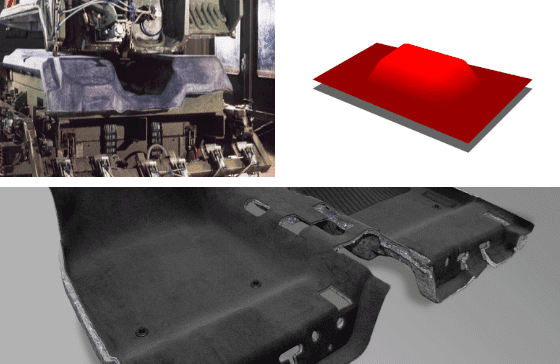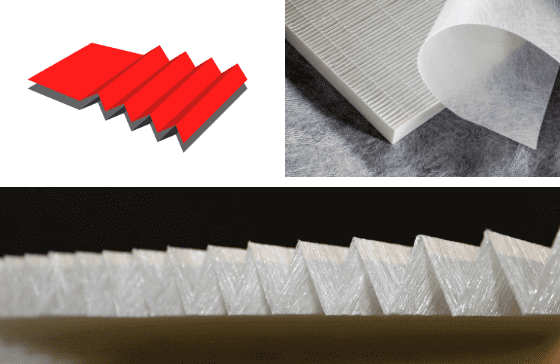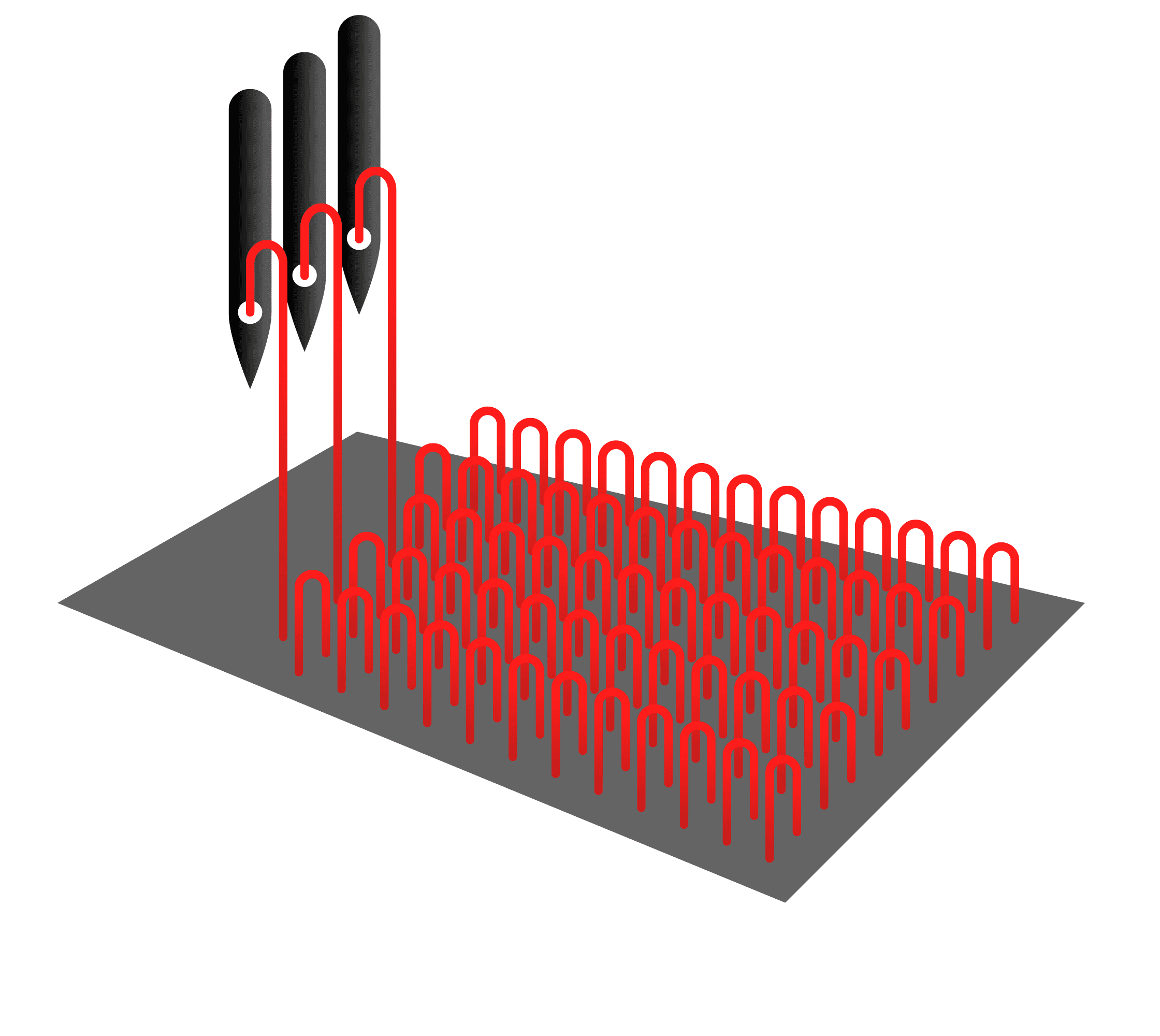All Colback non-woven fabrics have one thing in common: they can all be used in a wide range of industrial manufacturing processes. The unique set of properties of Colback non-wovens facilitates the manufacture of high-quality products whilst supporting design flexibility and process efficiency. One technology – endless possibilities.
Possibilities with Colback Nonwoven fabric

Coating
Colback non-woven fabrics consist of bi-component filaments with a polyester core covered in a sheath; the sheath can be chosen from a wide range of polymers. This design is unique in the non-wovens industry. Depending on the coating to be applied, the right product variant can be selected from a large product portfolio of non-woven fabrics. It includes materials that exhibit great affinity to PVC, TPU, latex, polyamide and many other coatings and glues.
The uniform distribution of Colback’s thermally-bonded filaments supports optimal distribution and penetration of the non-woven by the coating.

This property supports fast line speeds, thus optimizing production yield. At the same time, coating consumption is minimized, resulting in cost savings and reducing the environmental footprint of the manufacturing line. What’s more, where many other non-wovens show shrinkage during curing of the coating, Colback demonstrates stability. Because the fabric surface is very even, it is particularly suitable for knife coating.
Typical applications include:
Carrier for construction membranes
Ask a question about the process

Cutting
Imagine a fabric that’s as easy to cut as paper but still possessing strength and stability. If that’s what you’re looking for, spunbond Colback non-wovens are your answer.
Cutting process of Colback nonwoven fabric during production or in the final product is easy and dust free. The spunbond fabric can be cut with any common slitting technique including die-cutting. The non-woven is made by thermally bonding endless bi-component filaments to form the finished fabric. Thanks to the high number of filament bonding points, Colback is easy to cut straight (i.e. slitted) or in a pattern. The fabric is also suitable for punching. The non-woven’s edges will not fray or curl no matter what.

This is not only a key advantage in many manufacturing processes, but also in applications such as Liquid Applied Membranes .
Colback fleece in a LAM system allows for easy and precise cutting without fraying.
Wallpaper
Wallpaper with Colback as decoration is easy to apply but allows for easy and precise cutting.
Ask a question about the process

Embossing
The range of manufacturing technologies in which spunbond Colback non-wovens can be used is nearly infinite. Embossing processes, for example, are a more recent addition to the capabilities portfolio. The fabric is exceptionally suitable for creating raised patterns or designs using embossing in an industrial environment. This is due to the non-woven’s strength and stability as well as its deformability and resilience. Examples of embossing Colback include decorative (e.g. wallpaper) or functional applications (e.g. impact protection, spacers, ventilation, etc.).
Please note: The manufacture and/or sale of 3D deformed Colback may be covered by third party rights.
Ask a question about the process

Impregnation
Industrial impregnation processes are applied in the manufacture of a multitude of products. The Colback portfolio of spunbond non-wovens includes product variants, which are eminently suitable for impregnation with a variety of coatings such as latex or bitumen. This is thanks to their open surface and high evenness of mass enabling fast and full saturation.
As such they contribute to process stability and help maximize production yield.

Example of applications in which the ease of impregnation is among the key reasons for choosing Colback
Carrier & Reinforcement for Bitumen Membranes
Secondary backings for carpet tiles
Ask a question about the process

Lamination
When used in lamination processes, a key advantage of Colback is that its processing behavior is easy and smooth. Colback also helps speed up production by enabling products to be thinner and lighter in weight, yet again contributing to cost reduction and minimizing environmental impact.
Thanks to its unique nonwoven design based on bi-component synthetic filaments, the right product can always be selected to match the individual laminating process parameters.
Colback nonwoven fabrics facilitate lamination by means of thermal, adhesive and ultrasonic bonding. Colback is the ideal substrate for a diverse range of laminating materials like films and nonwovens.

Among the applications for which Colback has proven to be the ideal solution are:
Construction membranes: Membrane manufacturers use Colback because they can save on glue and they love the easy processing.
Air filters: Filter producers around the globe have confirmed the optimal processing behavior of Colback during lamination and pleating with multiple filter materials. Of course they also love the “bonus” that Colback contributes to the filter efficiency.
Decoration: Colback has proven suitable to be laminated with the most diverse materials allowing for new designs.
Ask a question about the process

Molding
With their high number of bonding points, Colback non-wovens are eminently suitable in a wide range of molding applications. The product range encompasses fabrics tailored to meet the requirements of different mold depths and process settings.
The fabric’s dimensional and thermal stability enable uniform elongation and controlled deformation in the most complex geometries. Colback facilitates deep drawing at low molding temperatures. This minimizes cycle times, so helping achieve savings in operating costs and energy consumption.

Manufacturers using high-temperature molding processes also value Colback’s contribution to stable production cycles. The automotive industry is among the sectors where Colback has been in use in molding processes for more than 25 years. Here, Colback serves as primary or secondary backing for molded car carpet. Of particular advantage in this application are the non-woven’s high strength and excellent molding behavior combined with low weight and consistent high quality from roll to roll and batch to batch.
Ask a question about the process

Pleating
What is as easy to pleat as paper but much tougher and more permeable? Colback spunbond non-wovens. Clients in the filtration industry especially value Colback for its excellent pleatability. The non-woven’s uniform structure of thermally bonded bi-component filaments and its high stiffness create this advantage. In addition to their stability even when under compression, pleats created with Colback are particularly sharp. This contributes to the optimal and long-term performance of the finished filter.

At the same time, the non-woven’s ease of processing and predictable behavior from roll to roll and batch to batch help maximize production yield. Apart from industrial manufacturers, increasing numbers of interior designers and producers of decorative products are taking advantage of Colback’s superior pleatability. Producers of window blinds take a keen interest in this feature
Ask a question about the process

Printing/Dyeing
Yet another process in which Colback delivers properties similar to those of paper yet combined with the benefits of a high-quality nonwoven: Colback can be easily printed on. And dyeing Colback is also simple. Thanks to the bi-component filament design with a polyester core and a choice of sheath from a wide range of polymers, the right product type can be selected from a large nonwoven product portfolio. This allows the requirements of the specific process to be precisely matched.

Examples of parameters which can be taken into account for optimal pattern definition and adhesion are the chemical composition of the dye, line speed and temperature. In addition, many different nonwoven weights are available. It is therefore not surprising that applications in which clients print on Colback or dye the fabric are increasing.
Examples of applications for which the nonwoven is suitable are:
Decorative applications such as tablerunners, flower wrapping, posters, folding screens and wallpaper.
Ask a question about the process

Tufting
Tufting is one of the processes in which Colback nonwovens have been used for decades. The product portfolio includes product variants containing special tuft finishes for optimal processing behavior and minimal wear of tuft needles.
The uniform open structure of Colback’s thermally bonded bi-component filaments guarantees optimal penetration with (pre)coatings. The result? Superb pile anchorage.

Colback nonwoven’s excellent tensile strength and dimensional stability facilitates complex tuft patterns while still allowing high tufting machine speeds. Other advantages in many tufting processes? The nonwoven’s tear strength exceeds that of most alternative fabrics. And sewing on Colback is easy.
Typical tufting applications include:
Ask a question about the process










